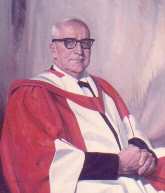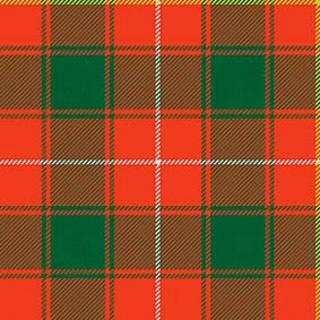
CLAN MACFIE SYMBOLS AND HISTORY
The above red and green Clan Macfie Tartan was recorded in the Books of the Court of the Lord Lyon on 29th August 1991.Thread count for the tartan is: 2 white/yellow; 24 red; 4 green; 2 red; 32 green Other Macfie tartans have been registered with The Scottish Tartans Society. |
The Wording On The Plaque On The Dun Eibhinn Cairn, Colonsay
DUN EIBHINN
The detached rocky knoll situated on the skyline directly in front of
the viewer is the site of Dun Eibhinn (Dun Eivan). This dun, or fort,
is believed to have been built by the High King Gillee Adamnan as a
royal residence in the early 11th century. It was a seat of Viking power
in the Western Isles and occupied by descendants of Gille Adamnan, including
Somerled and his grandson Donald, progenitor of Clan Donald. The fort
came into Clan Macfie possession in the early part of the 13th century.
The Macfie or MacDuffie Chiefs were Keepers of the Records for the Lords
of the Isles and the Clan provided many of the Priors for the Priory
on Oronsay. Malcolm, last Chief of Clan Macfie, moved from Dun Eibhinn
in the early 17th century and the fort fell into disuse from that time.
 |
Wording on the Macfie Standing Stone, Colonsay CARRAGH MHIC A PHI
|
CLAN MACFIE HISTORY
Although its origins are obscure, Clan Macfie is acknowledged as one of the oldest Scottish Clans. It has been claimed that the Clan originated in Ireland before becoming established in Scotland and this may well be the case. Traditionally though, it’s homeland is held to be the islands of Colonsay and Oronsay off the west coast of Scotland. A Clan presence in Lochaber, Galloway and on several other Hebridean islands is also evident from the earliest times.
The Gaelic spelling of the Clan name was MacDhubhsith. This became anglicised to MacDuffie or MacPhee which names appear interchangeable in some early manuscripts.
In keeping with the times, the early years of Clan history had their turbulent periods as well as those of stability and honour. The islands of Colonsay and Oronsay were visited by the Vikings during their domination of the Western Isles and used as a base for raids to the south. There was Macfie contact with Iona in 1164 which no doubt led to the building of the Augustinian priory on Oronsay some 160 years later with a MacDuffie traditionally the Prior.
Macfie of Colonsay was present at the Battle of Bannockburn in 1314 when Robert the Bruce defeated the English under Edward II. The Macfie Chief was the hereditary Custodian of the Records of the MacDonald Lords of the Isles. In 1463 Macfie of Colonsay appears as a member of the Council of the Isles and in 1549 a successor is recorded as holding lands on Jura in addition to those on Colonsay.
In 1531 Macfie of Colonsay was cited for treason, still being a supporter of the forfeited Lordship of the Isles. Clan clashes with the Macleans of Duart on Mull were frequent in the latter part of that century. In 1609 Macfie of Colonsay was one of a number of Hebridean Chiefs forced to sign the Statutes of Iona. But in 1615 Malcolm, the last Macfie Chief, supported the uprising of Sir James MacDonald and thus started a chain of events which culminated in his murder in 1623 by his former colleague Col Kitto MacDonald. With the death of Malcolm, the Clan was dispossessed of its lands and dispersed as a broken clan. No line of succession from Chief Malcolm has been established.
The Clan heartland then moved to Lochaber where many Macfies lived beside the Camerons. A Macfie was one of two pipers at Glenfinnan when Bonnie Prince Charlie raised his banner there in 1745. The following year many Clan members died on the right flank at Culloden fighting alongside the Camerons. They share a common grave on that desolate moor.
Clan fortunes waned and many members in Scotland and Ireland became caught up, either voluntarily or through compulsion, in the dispersal of the Scots to North America and later Australia and New Zealand.
In 1864 Grants of Arms were made to Robert Macfie of Langhouse and Airds and to Robert Andrew Macfie of Dreghorn, the first Clan members to be so honoured in the Public Register of All Arms and Bearings in Scotland. This Register had come into being in 1677, 54 years after the Clan’s last Chief was murdered. These Macfies were highly successful businessmen in the sugar industry and R. A. Macfie was elected Member of Parliament for Leith for a number of years.
The strap and buckle badge commonly depicted to-day as being that of Clan Macfie actually belongs to the Macfie of Dreghorn. The red and green Macfie tartan was probably originally designed at that time but it was not until 29th August 1991 that this tartan was formally recorded in the Books of the Court of the Lord Lyon as being the official Tartan of Clan Macfie.
In 1968 Dr. Earle Douglas MacPhee of Vancouver, BC, Canada, initiated a worldwide movement to have Clan Macfie recognised once again as an active clan and to have a new Chief appointed. Dr. MacPhee wrote a definitive history of the Clan, available to download here, and encouraged the formation of Clan Macfie Societies in all centres of major Clan population around the world. His efforts were highly successful with Clan Macfie being formally recognised by the Lord Lyon as an active clan on 27th May 1981. Dr. MacPhee was appointed the Clan’s first Ceann-Cath, or Clan Commander, on 6th November 1981, but sadly he died on 25th September the following year. To-day the 27th May is celebrated by Clan members worldwide as CLAN MACFIE DAY.

The late Dr.
Earle Douglas MacPhee
First Commander of Clan Macfie
On Colonsay, the Standing Stone against which the Clan’s last Chief, Malcolm, was stood and shot so many years ago has been repaired and has become a focal point for Clan members around the world. In 1993 the Clan’s second Ceann-Cath, or Commander, Alexander (Sandy) McPhie of Toowoomba in Queensland, Australia, had the honour of leading some 160 Clan members ashore on Colonsay for the Clan’s first organised return to it’s homeland islands in 370 years.
